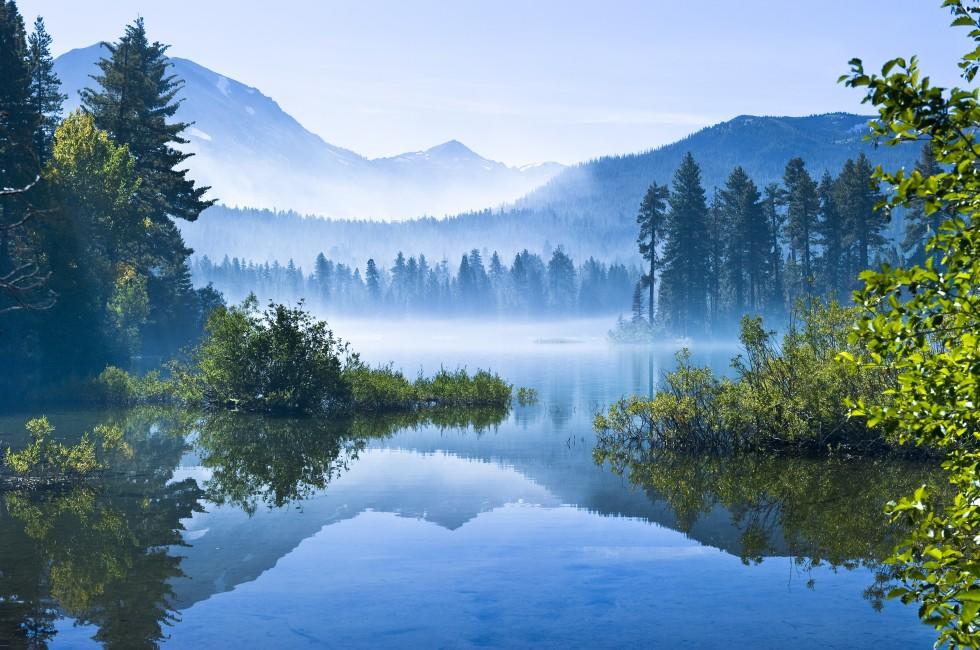Lassen Volcanic National Park
Lassen Volcanic National Park
Lassen Peak, a plug dome, is the most famous feature of this 166-square-mile tract of coniferous forests and alpine meadows. Its most spectacular outburst occurred in 1915, when it blew a cloud of ash almost 6 miles high. The resulting mudflow destroyed vegetation for miles and the evidence is still visible. The volcano finally came to rest in 1921 but is not considered dormant.
The area previously contained a pair of neighboring national monuments, each designated by President Theodore Roosevelt in 1907: Lassen Peak and Cinder Cone. The massive eruptions brought such attention to the region that in August 1916, the federal government combined the monuments and a significant chunk of land around them to create 106,452-acre Lassen Volcanic National Park.
Despite being located...
Read MoreLassen Peak, a plug dome, is the most famous feature of this 166-square-mile tract of coniferous forests and alpine meadows. Its most spectacular outburst occurred in 1915, when it blew a cloud of ash almost 6 miles high. The resulting mudflow destroyed vegetation for miles and the evidence is still visible. The volcano finally came to rest in 1921 but is not considered dormant.
The area previously contained a pair of neighboring national monuments, each designated by President Theodore Roosevelt in 1907: Lassen Peak and Cinder Cone. The massive eruptions brought such attention to the region that in August 1916, the federal government combined the monuments and a significant chunk of land around them to create 106,452-acre Lassen Volcanic National Park.
Despite being located in populous California, Lassen is among the less-visited national parks. Farther from the state's bigger cities than Yosemite, Joshua Tree, and other buzzier parks, it requires a bit of time and effort to get to. It also contains relatively few visitor services. And then there's the name, Lassen Volcanic, which misleadingly gives many the impression that the park is focused on one singular feature, the peak for which it's named.
In fact, the landscape in this underrated park is tremendously varied and surprisingly lush. The peak itself is undeniably impressive (and great fun to hike), but arguably more memorable are the three active hydrothermal areas within its shadow—Sulphur Works, Bumpass Hell, and Devils Kitchen—which delight with up-close views of frothy mudpots, steamy fumaroles, and boiling springs reminiscent of those found at Yellowstone, only minus the jostling crowds. The Cinder Cone, in the park's remote but accessible northeastern corner, is another star feature.
Lakes here range from hot and forbidding Boiling Springs Lake to refreshing, deep-blue Manzanita, Summit, Butte, and Juniper lakes—ideal for fishing, swimming, and nonmotorized boating. Well-marked trails connect these marvelous waters and hydrothermal areas with lofty peaks, wildflower-strewn meadows, and alpine forests rife with Western hemlocks, Douglas firs, and Ponderosa pines.
Lassen also has a handful of pleasant man-made structures, including the 1909 Drakesbad Guest Ranch, the 1927 Loomis Museum, and, at the park's southwestern entrance, the airy, contemporary, LEED-certified Kohm Yah-mah-nee Visitor Center.
Thanks to renewed interest in camping and off-the-beaten-path adventures (and to social media) Lassen's annual visitor numbers have been increasing. For now, though, one of California's greatest natural wonders still offers plenty of solitude.








